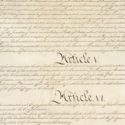If you read much about Puerto Rico in the news, you’ll have noticed the phrase “Territorial Clause” in reports and commentaries about the Island. It gets referenced in discussions about Puerto Rico the same way that the Second Amendment gets referenced in conversations about gun control. But what is it?
The Territorial Clause is part of the U.S. Constitution. There are two parts to Section 3: the first part says that Congress can make new states, and the second part — the Territorial Clause — says that Congress has full power over territories. 32 of the current 50 states were territories before they became states, so the Territorial Clause was and still is a necessity. There is plenty of talk about the relationships among the states and between the individual states and the federal government, but there still had to be some mention in the Constitution of territories: lands belonging to the United States which were not yet states.
So here’s what the Founding Fathers came up with:
“The Congress shall have power to dispose of and make all needful Rules and Regulations respecting the Territory or other Property belonging to the United States.”
The President signs laws passed by Congress but can’t make policy about territories. The people living in a territory can’t make rules or regulations for a territory except as allowed by Congress. The Supreme Court can interpret regulations for territories, but Congress has the express power to make rules for territories. Congress has to determine how to integrate a territory into the nation or dispose of a territory by granting independence or ceding sovereignty over the territory to another nation.
The effect of the Territorial Clause is that Congress has plenary power — meaning the territory has no status or rights except as permitted by Congress – over all territories belonging to the United States.
The federal government has said repeatedly that Puerto Rico is still a territory and therefore still falls under the Territorial Clause. The courts have ruled repeatedly that Puerto Rico is under the Territorial Clause. In a 1997 report from the General Accounting Office, this was explained very clearly:
Congress’s decision to permit self governance in Puerto Rico did not remove Puerto Rico from the application of the Territorial Clause. The Court concluded that there has been no fundamental alteration in Puerto Rico’s relationship with the United States; Puerto Rico is still constitutionally a territory, and not a separate sovereign.
The recent Department of Justice brief in the Supreme Court case which touches on the question of whether Puerto Rico has sovereignty or not says it again:
The Constitution neither recognizes nor affords independent sovereignty to territories but instead grants plenary authority to the United States: “The Congress shall have Power to dispose of and make all needful Rules and Regulations respecting the Territory or other Property belonging to the United States.”
What the Territorial Clause means is that Puerto Rico’s chance for equality depends on Congress. There is no alternative, no workaround, and no point in looking elsewhere. We have to demand that Congress take action on Puerto Rico’s status now. If you live in one of the 50 states, you have a representative in Congress. Find his or her Twitter handle at Verified and tell them that you want equal rights for Puerto Rico through statehood.








5 Responses
Equal rights now!!
[…] power to provide these tools for Puerto Rico, and Weiss recommended that there be an act under the Territorial Clause to get it […]
[…] is no agreement at all. Puerto Rico is a territory of the United States, subject to the Territory Clause of the Constitution, and reform is not a possibility. So it appears that Bernie Sanders is not completely clear on the […]
[…] The 2005 Report by President’s Task Force on Puerto Rico’s Status confirmed again that Puerto Rico was subject to the Territorial Clause. […]
[…] States, but not a part of the United States.” The Constitution’s territorial clause gives Congress the power to determine which parts of the Constitution apply to territories and which do […]